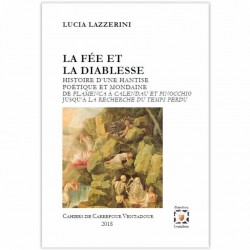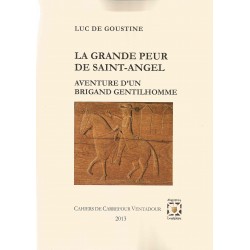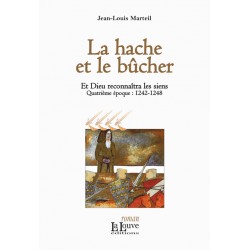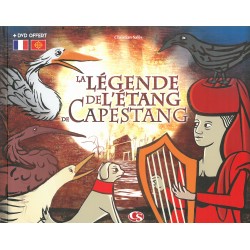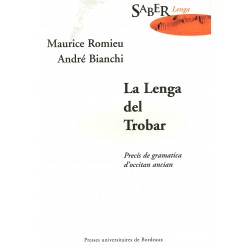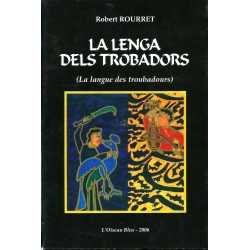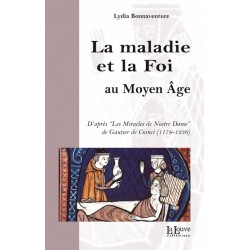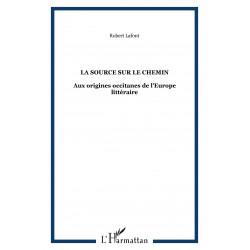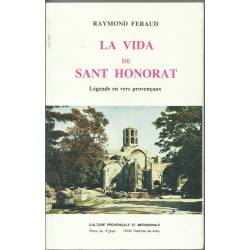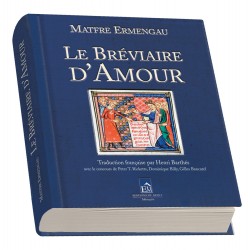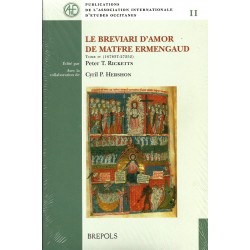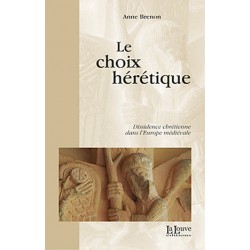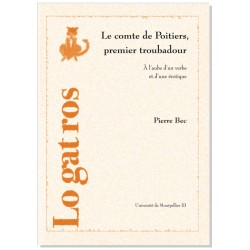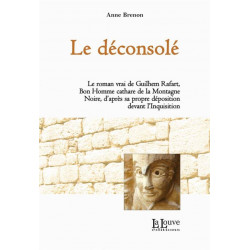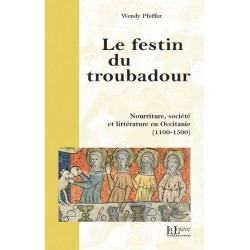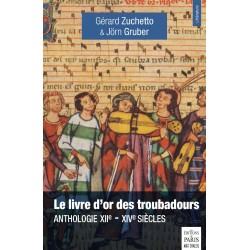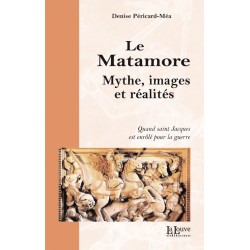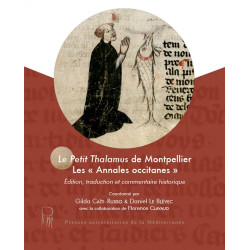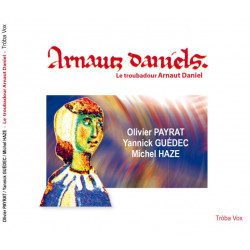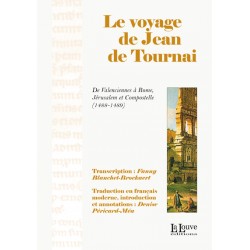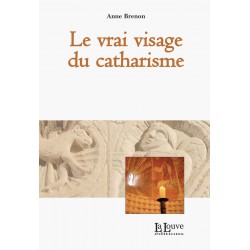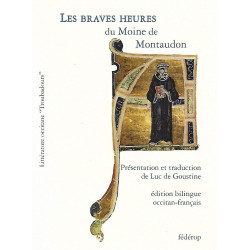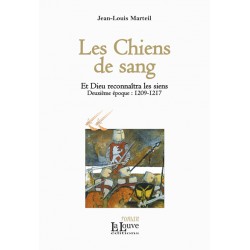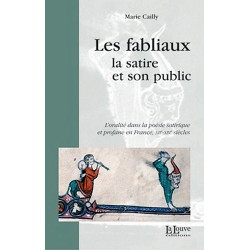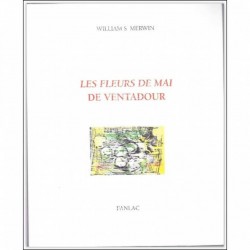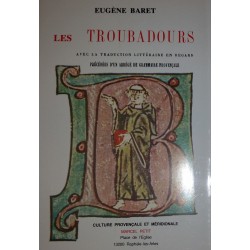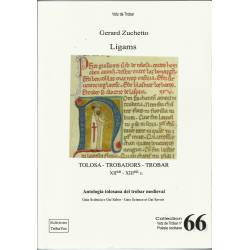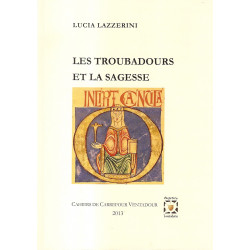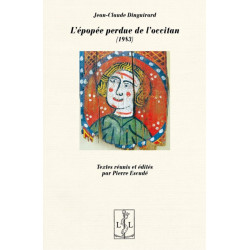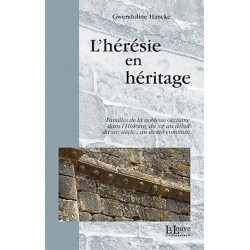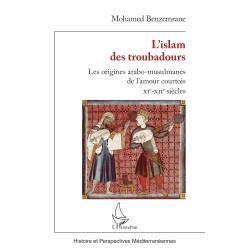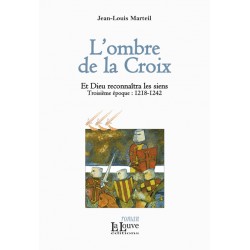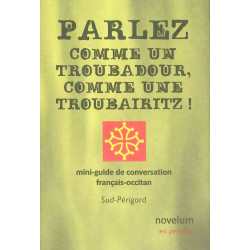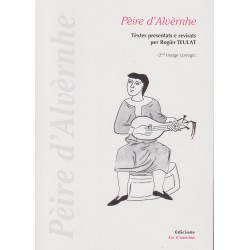Recently added item(s)
No products
Product successfully added to your shopping cart
There are 0 items in your cart. There is 1 item in your cart.
Troubadours
- New Selection
- Books
- Music
- Videos - DVD
- Miscellaneous
- Revues, Journaux
Specials
-

Viatges - La Bugade
16,00 € -33.33% 24,00 €
Links

Troubadours
Books about troubadours, men and women, whether Occitan or not.
A troubadour (trobador) was a composer and performer of Old Occitan lyric poetry during the High Middle Ages (1100–1350). Since the word troubadour is etymologically masculine, a female troubadour is usually called a trobairitz.
The troubadour school or tradition began in the late 11t...
Books about troubadours, men and women, whether Occitan or not.
A troubadour (trobador) was a composer and performer of Old Occitan lyric poetry during the High Middle Ages (1100–1350). Since the word troubadour is etymologically masculine, a female troubadour is usually called a trobairitz.
The troubadour school or tradition began in the late 11th century in Occitania, but it subsequently spread into Italy and Spain. Under the influence of the troubadours, related movements sprang up throughout Europe: the Minnesang in Germany, trovadorismo in Galicia and Portugal, and that of the trouvères in northern France. Dante Alighieri in his De vulgari eloquentia defined the troubadour lyric as fictio rethorica musicaque poita: rhetorical, musical, and poetical fiction. After the "classical" period around the turn of the 13th century and a mid-century resurgence, the art of the troubadours declined in the 14th century and eventually died out around the time of the Black Death (1348).
The texts of troubadour songs deal mainly with themes of chivalry and courtly love. Most were metaphysical, intellectual, and formulaic. Many were humorous or vulgar satires. Works can be grouped into three styles: the trobar leu (light), trobar ric (rich), and trobar clus (closed). Likewise there were many genres, the most popular being the canso, but sirventes and tensos were especially popular in the post-classical period, in Italy and among the female troubadours, the trobairitz.
La Canta de Rotland (La Chanson de Roland)...
La Canta de Rotland - Translation in Occitan by Pierre Bec of the Chanson de Roland considered (a little fast?) as the epic of the French nation, but which conceals many mysteries.
18,00 €LA DAME-GRAAL, chansons de Rigaud de...
La Dame-Graal, chansons de Rigaud de Barbezieux - The fabulous erotic-poetic adventure of a poet of oc language. Translation and presentation by Katy Bernard. 7th of the collection Troubadours, published by Federop.
14,00 €La Fée et la diablesse - Lucia Lazzerini
La Fée et la diablesse : Histoire d'une hantise poétique et mondaine de Flamenca à Calendau et Pinocchio jusqu'à La Recherche du temps perdu. Une enquête littéraire particulièrement originale de Lucia Lazzerini. Éditions Carrefour Ventadour.
24,00 €La hache et le bûcher - Jean-Louis Marteil...
La hache et le bûcher - Jean-Louis Marteil - Et Dieu reconnaîtra les siens (quatrième époque : 1242-1248). La Louve éditions.
14,00 €La légende de l'étang de Capestang (Book +...
La légende de l'étang de Capestang (book + DVD). L'extraordinaire aventure d'une jeune fille musicienne, qui au Moyen Age, près d'un étang, parle aux oiseaux. Les illustrations ont été réalisées à partir des peintures médiévales du plafond du château de Capestang. Editions Christian Salès.
14,90 €La Lenga del Trobar - Maurice Romieu,...
La Lenga del Trobar - Maurice Romieu, André Bianchi. Precís de gramatica d'occitan ancian (Précis de grammaire d'occitan ancien). Ce Précis réunit tout ce qu'il faut savoir de l'ancien occitan pour lire les troubadours et les textes de la littérature occitane du Moyen Âge. Presses Universitaires Bordeaux. ÉPUISÉ chez l'éditeur. Des clients le cherche...
21,00 €La lenga dels trobadors - Robert Rourret
La lenga dels trobadors - Initiation to what was the first poetic language of medieval Europe, by Robert Rourret.
16,00 €La main de Dieu - Jean-Louis Marteil - Et...
La main de Dieu - Jean-Louis Marteil - Et Dieu reconnaîtra les siens (première époque : 1206-1209). La Louve éditions.
14,00 €La poésie hispano-arabe et les premiers...
La poésie hispano-arabe et les premiers troubadours d'Aquitaine - Le livre de Aloïs Richard NYKL, sur la poésie hispano-arabe et ses liens avec les anciens troubadours a eu une influence énorme chez les arabisants, les romanistes et les hispanistes.
18,00 €La poésie Lyrique et Satirique en France...
La poésie Lyrique et Satirique en France au Moyen Age - Léon Clédat Éditions CPM Marcel PETIT.
15,00 €La source sur le chemin - Robert Lafont
La source sur le chemin - Aux origines occitanes de l'Europe littéraire - Une nouvelle conception du poète lyrique et de son œuvre par Robert Lafont. L'Harmattan.
47,30 €La Tròba, l'invention lyrique occitane des...
La Tròba, Occitan lyrical invention of the troubadours XIIe - XIIIe centuries, Anthology commented about Trobar by Gérard Zuchetto BOOK ON SALE
40,00 €Las nòvas del papagai - Arnaut de Carcassés
Las nóvas del papagai - Arnaut de Carcassés. Couverture de Corinne Cathy. Fédérop.
8,38 €Le Bréviaire d'Amour - Matfre Ermengau
Le Bréviaire d'Amour de Matfre Ermengau de Béziers (1288) - Traduction française Henri Barthés avec le concours de Peter Ricketts, Dominique Billy et Gilles Bancarel. Le Bréviaire d’Amour repose sur la notion universelle de l’Amour qui descend, comme tout don parfait, du Père des Lumières, car dit saint Jean : Dieu est Amour. Éditions du Mont.
120,00 €Le Breviari d’amor de Matfre Ermengaud -...
Le Breviari d’amor de Matfre Ermengaud - Tome IV - Peter T. Ricketts, avec la collaboration de Cyril P. Hershon. Publications de l'Association Internationale d'Etudes Occitanes (PAIEO 2), Brepols.
69,00 €Le Breviari d’amor de Matfre Ermengaud -...
Le Breviari d’amor de Matfre Ermengaud - Tome V (27252t-34597) - Deuxième édition entièrement refondue, édité par Peter T. Ricketts, avec la collaboration de Cyril P. Hershon. Publications de l’Association Internationale d’Etudes Occitanes (PAIEO 7) - Turnhout, Brepols.
89,00 €Le choix hérétique - Dissidence chrétienne...
Le choix hérétique - Dissidence chrétienne dans l'Europe médiévale - Anne Brenon
21,00 €Le comte de Poitiers premier troubadour -...
Le comte de Poitiers premier troubadour - Pierre Bec - A l'aube d'un verbe et d'une érotique. Passionnante énigme que ce Guilhem d’Aquitaine: personnage historique ou nom conféré à un ensemble de textes ? Premier troubadour connu, il donne l’impression qu’avec lui la première des poésies en langue vernaculaire naît déjà dotée de perfection formelle et...
13,00 €Le déconsolé - Anne Brenon
Le déconsolé - Anne Brenon. Fondée sur des sources historiques, l'histoire de Guilhem, humble vacher de la Montagne Noire victime du tribunal de l'Inquisition, immerge le lecteur dans la société de la fin du XIIIe siècle et illustre la fin tragique du catharisme. La Louve éditions.
19,00 €Le festin du troubadour - Wendy Pfeffer
"Le festin du troubadour" par Wendy Pfeffer Nourriture, société et littérature en Occitanie (1100 - 1500)
26,00 €Le livre d'or des troubadours - Gérard...
Le livre d'or des troubadours - Anthologie XIIe - XIVe siècles par Gérard Zuchetto et Jörn Gruber.
20,00 €Le Loup amoureux - Peire Vidal
Le Loup amoureux - Peire Vidal. "Peire amava la Loba de Puegnautier... e se fasiá apelar lop per ela e portava armas de lop" (Peire aimait la Louve de Pennautier... et [il] se faisait appeler loup pour elle et portait des armes de loup), raconte la Vida du troubadour. Vitalité du désir jointe à l'extravagance du comportement : un troubadour du 12e siècle...
14,00 €Le néant et la joie - Guillem d'Aquitaine
Le néant et la joie (Nothingness and Joy) - Katy Bernard presents a book to get acquainted with the first troubadour: Guillaume d'Aquitaine, who has experimented with many poetic paths: farewell singing, grivois singing, singing of love, singing of nothing. Bilingual edition.
14,00 €Le Petit Thalamus de Montpellier - Les «...
Le Petit Thalamus de Montpellier - Les « Annales occitanes » - G. Caïti-Russo, D. Le Blévec. Édition, traduction et commentaire historique, coordonné par Gilda Caïti-Russo et Daniel Le Blévec, avec la collaboration de Florence Clavaud. Presses universitaires de la Méditerranée – PULM.
48,00 €Le troubadour Arnaut Daniel (CD)
Le Troubadour Arnaut Daniel - CD d'Olivier PAYRAT, Yannick GUEDEC et Michel HAZE. Trois passionnés de l'œuvre des troubadours relèvent le défi de chanter "à contre courant" les folles paroles d'un ciseleur de mots qui voulait faire rimer quête d'amour avec perfection artistique, art d'amor avec art de trobar. Textes de Gérard ZUCHETTO d'après le manuscrit...
15,00 €Le troubadour Marcabru et ses...
Le troubadour Marcabru et ses contemporains - Collectif : Peter Ricketis, Barbara Spaggiari, Maurizio Perugi, Brice Duisit, Peter Davis, Catherine Léglu. Cahiers de Carrefour Ventadour 2007. Carrefour Ventadour.
12,00 €LE VRAI VISAGE DU CATHARISME - Anne Brenon
Le Vrai Visage du Catharisme - Anne Brenon. Réédité une vingtaine de fois depuis sa première parution, cet ouvrage est la référence absolue pour l'histoire du catharisme : très documenté et abordable par tous publics. La Louve éditions.
19,00 €Les Braves heures du Monge de Montaudon -...
Les Braves heures du Monge de Montaudon - Présentation et traduction de Luc de Goustine. Collection "Troubadours", editions Fédérop.
15,00 €Les Chiens de sang - Jean-Louis Marteil -...
Les Chiens de sang - Jean-Louis Marteil - Et Dieu reconnaîtra les siens (deuxième époque : 1209-1217). La Louve éditions.
14,00 €Les Fabliaux - La satire et son public -...
Les Fabliaux - La satire et son public - L’oralité dans la poésie satirique et profane en France, XIIe-XIVe siècles - Marie Cailly. Étalés sur deux siècles, les fabliaux montrent l’évolution des mentalités, la réception des textes profanes mis à l’écrit et l’essor d’une littérature vraiment “populaire”. La Louve.
20,00 €Les fleurs de mai de Ventadour - William...
Les fleurs de mai de ventadour - William S. Merwin. Un excellent guide vers des richesses quasi ignorées, dont on découvrira qu'elles sont au coeur de notre tradition. Ventadour, étrange domaine poétique dont la célébrité mondiale demeure retentissante, alors qu'au fond de la montagne limousine les décombres de son château paraissent depuis deux siècles...
18,00 €Les troubadours - Leurs vies, leurs...
Les troubadours - Leurs vies, leurs œuvres, leur influence - Joseph Anglade. Ce livre a pour ambition de faire connaître au public et sous une forme accessible - dépourvue de l'appareil d'érudition qui accompagne d'ordinaire ces études - une période glorieuse de notre ancienne littérature. Éditions des Régionalismes.
19,95 €Les troubadours et la cour des Malaspina -...
Les troubadours et la cour des Malaspina - Gilda Caïti-Russo. Lo gat ros. Presses Universitaires de la Méditérranée. Université Paul-Valéry Montpellier III.
14,00 €Les Troubadours et leur influence sur la...
Les Troubadours et leur influence sur la littérature du midi de l'Europe (avec la traduction littéraire en regard) - Un livre d'Eugène Baret précédé d'un abrégé de grammaire provençale par les éditions C.P.M. Marcel Petit.
15,00 €Ligams - Gerard Zuchetto
Ligams - Gerard ZuchettoTolosa - Trobadors - Trobar XIIe - XIIIeAntologia tolosana del trobar medieval
20,00 €Lucia Lazzerini - Les Troubadours et la...
Les Troubadours et la Sagesse - Lucia Lazzerini. Pour une relecture de la lyrique occitane du Moyen Âge à la lumière des quatre sens de l'Écriture et du concept de "Figura". L’interprétation courante de la lyrique des troubadours donne ces poètes pour les chantres élégants de l’amour dit « courtois ». Carrefour Ventadour.
18,00 €L’AMOUR, LA SEXUALITÉ ET L’INQUISITION -...
L’AMOUR, LA SEXUALITÉ ET L’INQUISITION - Un paradoxe : les expressions de l’Amour dans les registres d’Inquisition (XIII°-XIV° siècles) - Gwendoline Hancke. La Louve éditions.
19,00 €L’Épopée perdue de l’occitan (1983) -...
L’Épopée perdue de l’occitan (1983) - Jean-Claude Dinguirard. De nombreux indices attestent de l'existence d'une littérature épique occitane presque entièrement perdue. Ce livre s'appuye sur des découvertes en linguistique, en philologie, en poétique, en ethnographie et en histoire. Investigation dans la quête des littératures d'oc, particulièrement de...
25,00 €L’islam des troubadours - Les origines...
L’islam des troubadours - Les origines arabo-musulmanes de l’amour courtois - XIe-XIIe siècles - Mohamed Benzemrane. (The Arab-Muslim origins of courtly love, 11th-12th centuries). Arab-Muslim roots of courtly culture. How Arab civilization inaugurated an elevated conception of love and an art of loving that inspired the West in the Middle Ages, as...
38,00 €L’ombre de la Croix - Jean-Louis Marteil -...
L’ombre de la Croix - Jean-Louis Marteil - Et Dieu reconnaîtra les siens (troisième époque : 1218-1242). La Louve éditions.
14,00 €Paratge & Vilania - Miquèla Stenta
Paratge & Vilania - Miquèla Stenta. Every civilization, every society, has its own values. And the names to express them. So it was in the 12th and 13th centuries in the Pays d'Oc. Paratge and Vilania, a patriotic emblem for one, a downfall for the other. This study takes stock of the situation, based on the Trobadorenc corpus. Collection Vendémias, IEO...
10,00 €Parlez comme un troubadour, comme une...
Parlez comme un troubadour, comme une troubairitz ! - Tomàs Irondela - mini-guide de conversation français-occitan. Ce livret présente des expressions de tous les jours, un petit guide de l'occitan de tous les jours : comment se saluer, bavarder, commander au restaurant... et quelques chansons parmi les plus connues. Editions Novelum - IEO Perigòrd.
4,00 €Passages inédits (Sagesse, Ecclésiastique)...
Passages inédits (Sagesse, Ecclésiastique) de la Bible vaudoise - Claudine Fréchet. Unpublished passages (Wisdom, Ecclesiasticus) from the Waldensian Bible in medieval Occitan, manuscript 258, Trinity College Library, Dublin. Transcription & literal French translation. One of the biblical texts translated into Occitan during the Middle Ages, on the...
27,00 €Pèire d'Alvèrnhe - Tèxtes presentats e...
Pèire d'Alvèrnhe - Tèxtes presentats e revirats per Rogièr Teulat. Les chansons du fameux troubadour Pierre d'Auvergne présentées par Roger Teulat. 2nd tirage corrigé aux éditions Lo Convise.
20,00 €
 English
English Français
Français Occitan
Occitan


